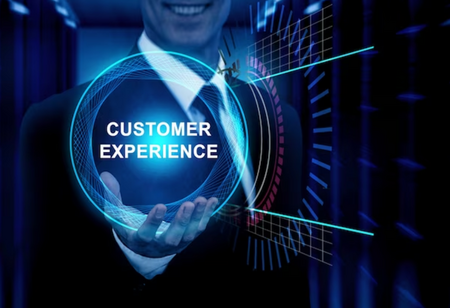Power of Immersive Customer Experience (ICE) in Steering Business
By Samrat Pradhan, Editor, Consultants Review
 It has been rightly said that in the absence of a good strategy and planning, no technology can be 'The Answer' to drive better customer experience. In this context, Immersive Customer Experience can be the perfect weapon of choice to devise a comprehensive approach that involves engaging customers in a multi-sensory, interactive, and deeply engaging contact with a company. Furthermore, this goes beyond the typical limitations of consumer interaction, attempting to build emotional bonds and long-term relationships. This experience frequently incorporates technology such as virtual reality (VR), augmented reality (AR), mixed reality (MR), or even sensory aspects to immerse clients in a distinct and unforgettable world associated with the brand.
It has been rightly said that in the absence of a good strategy and planning, no technology can be 'The Answer' to drive better customer experience. In this context, Immersive Customer Experience can be the perfect weapon of choice to devise a comprehensive approach that involves engaging customers in a multi-sensory, interactive, and deeply engaging contact with a company. Furthermore, this goes beyond the typical limitations of consumer interaction, attempting to build emotional bonds and long-term relationships. This experience frequently incorporates technology such as virtual reality (VR), augmented reality (AR), mixed reality (MR), or even sensory aspects to immerse clients in a distinct and unforgettable world associated with the brand.
“The most important thing is to obsessively focus on the customer. It’s our job every day to make every important aspect of the customer experience a little bit better.” - Jeff Bezos, Chairman, Amazon
Understanding Every Facets of Devising Intuitive Experience
So, let’s assume a line on a graph that scores your consumers' sentiment at every touch point where they interact with your firm, goods, or services. This represents the concept of the customer experience. While a company might typically create a business model around excellent quality or value, the motivation in 2024 would be to ensure that every connection and experience makes the customer heartedly smile. This includes personalized marketing that offers what clients require at the appropriate time, on-time delivery, hassle-free setup and installation, and rapid problem resolution. To put this into a practical scenario, companies and brands are increasingly appointing Chief Experience Officers to guarantee that these ideas are properly integrated into all business initiatives.
If we look at a prediction according to experience consultancy Walker, customer Experience (CX) is expected to overtake price and product as the key brand differentiator by next year. More than two-thirds of marketers responsible for delivery say their companies now mainly compete based on CX (Gartner). But agreement on what Customer Experience includes and what matters in shaping a winning strategy to meet customer expectations is still a matter of debate.
Aligning Oneself with Customer’s Desires
So what is CX? Forrester defines CX in a single sentence: "How customers perceive their interactions with your company." It is important to note that there might be a worrisome gap between what a brand sees the quality of its experience to be and what the consumer believes. Businesses are continuously looking for new ways to capture their audience in the ever-changing landscape of consumerism. A breakthrough technique has arisen beyond traditional marketing strategies, one that goes beyond ordinary transactions to produce lasting impressions - Immersive Customer Experience (ICE). This unique approach is redefining the dynamics of customer connection, raising it to a whole new level by offering consumers an interactive and memorable journey.
How Does ICE Drive Sales and Growth for Businesses?
Emotional Connection and Brand Loyalty: Immersive experiences forge emotional connections between customers and brands. By providing an immersive encounter, businesses can create a strong sense of attachment and loyalty among customers, leading to repeat purchases and brand advocacy.
Enhanced Engagement and Memorability: Immersive experiences are designed to be memorable. This means that when the customers are deeply engaged in an interactive and unique encounter, they are more likely to remember the brand and its offerings. Hence, this increased retention directly impacts sales and referrals.
Personalization and Customization: ICE allows for tailored experiences. By leveraging customer data and preferences, businesses can create personalized immersive experiences that cater to individual needs, preferences, and desires. This customization enhances the overall satisfaction and likelihood of conversion.
Differentiation and Competitive Edge: In a saturated market, standing out is crucial. Immersive experiences differentiate a brand from its competitors. Businesses that offer unique and captivating experiences tend to attract more attention and gain a competitive edge in the market.
Data Collection and Insights: Immersive experiences often involve the use of technology that enables data collection in real-time. This data provides valuable insights into customer behavior, preferences, and pain points, enabling businesses to refine their strategies and offerings for better sales and growth.
Now let’s look into some noteworthy case studies when it comes to the successful Implementation of Immersive Customer Experience Methodologies:
IKEA: The furniture giant introduced an AR app that allows customers to visualize how furniture will look in their homes before making a purchase, enhancing their shopping experience and boosting sales.
Red Bull: Through its VR initiatives, Red Bull has offered immersive experiences, allowing customers to virtually participate in extreme sports events. This engagement strengthens brand loyalty among its target audience.
BMW: This automotive company has utilized VR technology to offer virtual test drives, giving potential customers a realistic and immersive experience of their vehicles, leading to increased sales and customer satisfaction.







